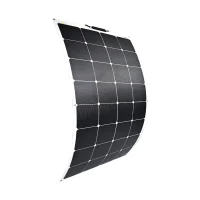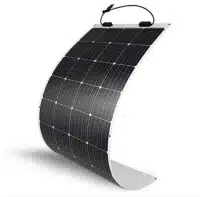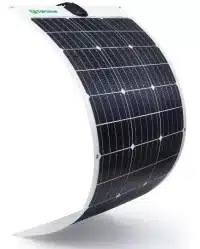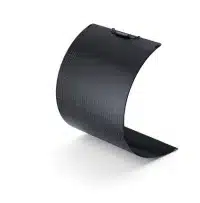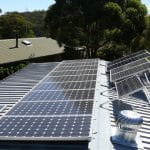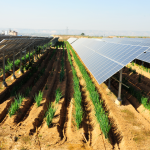As 2024 unfolds, the role of flexible solar panels in the renewable energy landscape becomes ever more pivotal. No longer just a niche innovation, flexible solar panels have surged to the forefront of cutting-edge technology, offering a dynamic, lightweight, and highly efficient alternative to the traditional rigid solar panels. Constructed from state-of-the-art photovoltaic materials, these panels are designed to withstand bending and flexing without damage, making them perfectly suited for a diverse array of applications.
Whether seamlessly melding into the contours of boats and recreational vehicles or providing essential, portable power solutions for hiking trips and emergency situations, their versatility shines through. Enhanced by their portability, these flexible solar panel kits frequently feature integrated power outlets designed for small appliances, and they are equipped with portable power stations to facilitate off-grid charging, marking them as indispensable tools in the pursuit of sustainable energy solutions.
Table of Contents
Our top choices
Which Best Flexible Solar Panels?
#1 Sungold 120W 12V Flexible Monocrystalline Solar Panel
For those venturing into off-grid power systems, Sungold stands as a leading choice. Their expansive selection ranges from 60W to 295W flexible solar panels. These panels employ either SunPower cells or monocrystalline designs, synonymous with superb energy efficiency. Notably, the SunPower-designed flexible modules are robust enough to withstand being stepped on and are remarkably 75% lighter than their rigid counterparts. Below are some of the standout features:
Key features include:
– Comprised of 36 monocrystalline solar cells arranged in a 3×12 configuration.
– Boasts a module efficiency of 20.52%.
– Designed to operate within a temperature range of -40°F to 185°F (-40°C to 85°C).
– Features SunPower back-contact solar cells, one of the most efficient technologies in the solar industry.
– Comes with a six-year warranty on materials and workmanship, promising a longevity of 20 years.
#2 Renogy 100W 12V Flexible Monocrystalline Solar Panel
If you’re in the market for an off-grid power solution, Renogy stands out as one of the premier brands. Their selection spans flexible solar panels ranging from 50W to 200W. Renogy employs monocrystalline cells, ensuring that their solar panels offer superior energy efficiency.
The Renogy 100W 12V flexible monocrystalline solar panel is significantly lighter, weighing 75% less than comparable rigid panels. Below are some of the key features of this product:
Key features include:
– Consists of 36 monocrystalline solar cells arranged in a 9×4 configuration.
– Module efficiency stands at 14.9%.
– Designed to operate within a temperature range of -40°F to 185°F (-40°C to 85°C).
– Capable of bending up to 248 degrees.
– Incorporates half-cut PERC solar cells, among the most efficient technologies available in the industry.
– Features an IP67-rated waterproof casing.
– Comes with a five-year warranty on materials and workmanship.
#3 Topsolar 100W Flexible Solar Panel
Topsolar provides a varied assortment of flexible solar panels, ranging from 20W to 300W. These panels feature photovoltaic cells manufactured by SunPower, which are distinguished by their industry-leading efficiency rates of 22% to 25% under laboratory conditions. Topsolar’s flexible solar panels are designed with an ultra-slim profile, measuring less than 0.1 inches in thickness.
Key features include:
– 32 monocrystalline solar cells arranged in a 4×8 configuration.
– Solar cell efficiency of 19.9%.
– Operating temperature range from -40°F to 185°F (-40°C to 85°C).
– Encased in an IP67 waterproof casing.
– Exceptional durability: engineered to withstand accidental stepping.
– One-year product warranty.
#4 ALLPOWERS 50W 18V 12V Flexible Solar Panel
The ALLPOWERS 50W 18V 12V flexible solar panel is one of those striking, robust panels crafted for sustainable outcomes. If longevity is your goal, this panel is a masterpiece that will add value to your solar setup.
Key features include:
– 32 monocrystalline solar cells in a 4×8 configuration
– Solar cell efficiency: 19.9%
– Operating temperature range: -40°F to 185°F (-40°C to 85°C)
– IP67 waterproof casing
– Highly durable: the module is designed to withstand accidental stepping
– One-year product warranty
Flexible Solar Panels Buyer's Guide
Key Takeaways
Flexible solar panels offer a portable and lightweight solution for off-grid renewable energy generation, ideal for use in camping, boating, RVs, and beyond.
Designed to bend up to 30 degrees, they are highly versatile and easily installed on a variety of surfaces.
Although flexible solar panels are more affordable and portable compared to rigid solar panels, their capacity and durability are somewhat diminished, necessitating careful handling and maintenance.
What Are Flexible Solar Panels?
Flexible solar panels use photovoltaic cells to generate electricity, just like traditional rooftop solar panels. The major difference is that their PV cells are installed on a flexible material instead of a rigid aluminum and glass frame. Thanks to this design, flexible solar panels can fit on curved surfaces, or they can be folded and stored.
* They are designed to be smaller and lighter, with many models weighing less than 10 pounds.
* By comparison, traditional solar panels typically weigh between 35 and 50 pounds and range in length from 65 to 80 inches (5.4 to 6.7 feet).
* Utilizing such size and weight for portable power is impractical.
Before deploying flexible solar panels, it’s important to note that not all products can be completely folded. Some can be bent to a specified angle, but further bending might cause damage. Always check the manufacturer’s instructions.
How Do Flexible Solar Panels Work?
Flexible solar panels achieve efficient conversion of sunlight by covering a thin layer of photovoltaic material on a bendable support structure. The flexibility of this design allows flexible solar panels to be easily mounted on various surfaces, whether curved or flat, ensuring that the panels can obtain the optimal angle for sunlight exposure.
However, it should be noted that although flexible solar panels have advantages in terms of installation and adaptability, they tend to have lower durability and power output compared to traditional rigid solar panels. Generally, these panels produce between 50 and 300 watts of power, making them more suitable for applications with lower power requirements.
What Are the Different Types of Flexible Solar Panels?
MonoCrystalline Flexible Solar Panels
Crystalline flexible solar panels are made from the same silicon material as traditional rigid solar panels, which allows them to maintain a flexibility of up to 30 degrees. These panels are characterized by smooth edges and a dark surface, visually similar to traditional silicon panels. To achieve greater flexibility and thinness, each cell or panel is composed of solar cells cut to micron-level thicknesses.
Unlike traditional rigid panels that feature a glass layer, crystalline flexible solar panels use a thin, durable, and flexible protective plastic layer. This unique protective layer effectively extends the lifespan of the panels while maintaining excellent flexibility, enabling them to adapt to various installation environments.
Due to their outstanding durability and reasonable efficiency (typically ranging from 15% to 25%), crystalline flexible solar panels enjoy high popularity in the market and hold a leading position among all types of flexible solar panels. These panels are not only suitable for environments requiring high adaptability but also provide stable and reliable energy output, making them an ideal choice for those seeking both efficiency and flexibility.
Thin-Film Flexible Solar Panels
Thin-film flexible solar panels are distinctly lighter compared to crystalline solar panels. These panels are produced by applying photovoltaic materials onto lightweight substrates such as aluminum foil, cardstock, or even fabric. This innovative production technique significantly reduces the total weight of the solar panels, with some thin-film models weighing as little as 4 pounds. This reduction greatly increases their flexibility and convenience for various applications.
However, thin-film panels typically do not have a silicon protective layer, which makes them less durable than traditional crystalline solar panels. Despite this drawback, thin-film flexible solar panels are still highly favored for their lightweight and adaptability, making them particularly suitable for portable energy solutions or in applications where structural load-bearing is limited.
Flexible Panels Made from Organic Materials
In the solar panel manufacturing industry, organic solar cells are considered the future. This type of flexible panel forgoes traditional silicon in favor of organic materials used in solar cells.
Often dubbed “plastic solar cells/panels,” these flexible panels made from organic materials hold the potential to surpass the previously mentioned alternatives. Notably, they can be lighter, more flexible, and even more cost-effective. Crucially, the use of organic materials in their manufacture renders them more environmentally friendly.
With ongoing research in the organic solar cells arena, the future appears promising for these types of flexible solar panels.
Where Are Flexible Solar Panels Useful?
In the solar panel manufacturing industry, organic solar cells are considered the future. This type of flexible panel forgoes traditional silicon in favor of organic materials used in solar cells.
Often dubbed “plastic solar cells/panels,” these flexible panels made from organic materials hold the potential to surpass the previously mentioned alternatives. Notably, they can be lighter, more flexible, and even more cost-effective. Crucially, the use of organic materials in their manufacture renders them more environmentally friendly.
With ongoing research in the organic solar cells arena, the future appears promising for these types of flexible solar panels.
Due to their cost-effectiveness, portability, and light weight, flexible solar panels are an ideal solution for anyone seeking to live off-grid for a few days. They are versatile for various outdoor settings, including:
Powering Motor Homes
During long trips, these lightweight solar panels can be easily deployed on the roof of a motor home, supplying necessary power without the burden of heavy, rigid panels that can overload the vehicle’s structure.
Camping
Sometimes referred to as camping solar panels, they can power your tent or off-grid cabin during camping trips. When not in use, they can be conveniently rolled up and stowed inside the tent.
Power Backup
For those frequently on the road or in remote locations, flexible solar panels are an excellent backup power solution. To charge your devices, simply position the panels on the exterior surface of your vehicle where they can catch direct sunlight.
Boating Applications
Spending time on a boat, especially for fishing, can be less enjoyable with the noise and inconvenience of a generator. Luckily, flexible solar panels offer a quieter, more attractive alternative, likely making your fishing trips more peaceful and productive.
What Are the Advantages of Flexible Solar Panels?
| Advantages | Cons |
|---|---|
| Flexible | Limited Power |
| Versatility | Restricted Warranties |
How Do I Maintain My Flexible Solar Panels?
Although flexible solar panels are extremely suitable for certain applications, they tend to be less durable and more susceptible to damage.
Here are some tips to properly maintain your panels and ensure they serve you reliably for an extended period:
Avoid Cracking the Panels
Handling these panels carefully is essential to prevent the formation of microcracks within their structure. Such damage not only affects the product’s lifespan but also reduces its energy production capacity. You should avoid stepping on the panels or bending them beyond their specified limits. Direct exposure can cause the degradation of the protective layer around the panel. Thus, it is advisable to install them in a manner that allows for easy removal and storage when not in use.
Clean the Panels Periodically
Research by the Solar Energy Generation Association shows that the power output of flexible solar panels can decrease by as much as 20% due to the accumulation of dirt on the surface. Regular surface cleaning is crucial to maintain optimal efficiency. Clean water is the safest method for removing common contaminants like bird droppings and tree sap, which, if not promptly cleaned, can scratch the panel’s sensitive surface.
For tougher stains, such as grease, mild soap and water are recommended. It is strongly advised to avoid any corrosive cleaning agents during the cleaning process to prevent irreversible damage to the panel’s surface. Following these simple maintenance steps can effectively preserve the performance and prolong the lifespan of your flexible solar panels.
How Do You Mount a Flexible Solar Panel?
Mounting Flexible Solar Panels on an RV Using a Rack Mount
The installation of flexible solar panels on an RV can be completed in several key steps to ensure safety and optimal efficiency:
- **Assemble the Rack System**: Begin by assembling all necessary components, which include the rack, support arms, and fastening screws, following the provided instructions. This foundational step is crucial for ensuring a smooth installation.
- **Attach the Rack to the Solar Panel**: Secure the support arms to the back of the solar panel using the included fastening screws. During this step, insert locking washers to ensure a firm connection. Secure the rack between the two support arms using the hex bolts and nuts supplied in the kit.
- **Secure the Rack to the RV**: Mount the assembled rack onto the rear of the RV or camper. Use a wrench and screwdriver to tighten all hex bolts and washers, making sure the rack is firmly attached.
- **Adjust the Mounting Angle**: For maximum power output, ensure the solar panels are installed at the optimal angle. This adjustment may need to be made based on the RV’s parking position and the path of the sun.
- **Make Electrical Connections**: Lastly, complete the electrical connections between the panel and the junction box or battery as per the manufacturer’s instructions. Always use the specified connectors during this process to prevent any potential damage to the solar panels.
Following these detailed steps ensures not only a proper installation of the solar panels but also maximizes their energy efficiency, providing reliable and stable power for the RV.
Mounting Flexible Solar Panels Using an Adhesive
If you opt to use adhesive for installation, you must be very careful. Directly adhering the panels to the roof of a boat or RV can lead to overheating issues. Worse, the different expansion coefficients between the roof and the panels can cause cracks due to heating and cooling of these surfaces.
- **Create an Aluminum-Polyethylene Sandwich**: Start by using two thin aluminum sheets and polyethylene, all cut to the size of the panel, to create an aluminum-polyethylene sandwich.
- **Attach the Panel to the Aluminum Layer**: Use marine-grade adhesive to secure the panel to one side of the aluminum sandwich.
- **Use a Polycarbonate Layer**: Take a product with a twin-wall and an 8 mm air gap made of polycarbonate and adhere it to the panel-aluminum sandwich setup. Afterward, attach the entire setup to the roof of the boat or RV using a polycarbonate-friendly adhesive.
Remember, do not apply adhesive around the edges of the solar panel, as it might trap air underneath. When the solar panel heats up, these air pockets can expand, potentially damaging both the panel and the roof of the RV or boat.
Features to Look for in Flexible Solar Panels
Power
The power output of a solar panel, measured in watts, determines how many devices can connect to it and how long they can run. Flexible solar panels are available with power ratings ranging from 50 to 300 watts.
Efficiency
Efficiency measures the panel’s ability to convert absorbed sunlight into electric power. Most panels currently operate with efficiency ratings between 15% and 25%. Top-tier products can reach efficiencies of 23% to 25%.
Durability
Durability depends on the construction materials of the panel. Most incorporate a plastic protective layer to shield the photovoltaic cells. While cheaper materials like PTE and PET provide less protection and translucency, premium ETFE plastic offers superior durability. Thin-film panels, though less costly, do not match the structural strength of their crystalline counterparts.
Bending Angle
Flexible solar panels vary in how much they can bend. Crystalline flexible panels, the most popular type, can flex up to 30 degrees.
Installation
These panels can be mounted using adhesives, Velcro, or user-friendly rack systems, making DIY installations commonplace. The best panels are accompanied by straightforward, easy-to-follow instruction manuals.
Size and Weight
Most flexible solar panels are designed for portability, typically weighing between 4 and 8 pounds and maintaining a consistent size.
Warranty
A robust warranty signals a manufacturer’s confidence in their product’s quality, covering parts and power production.
Industry Credentials
Look for industry certifications such as IEC61215 and ISO9001 to verify the quality of the panels, which are indicative of a product’s adherence to high standards.
Our Expertise in Solar Products
Over the years, we have been at the forefront of solar technology, understanding the nuances and complexities of various solar innovations. Our team has hands-on experience with a variety of solar products, and we have witnessed the evolution of flexible solar panels from their initial stages to today’s cutting-edge options.
Final Thoughts.
Flexible solar panels are convenient and easy-to-use portable solar panels that can be deployed in many situations, including camping, sea travel/boating and long road trips.
High-quality panels can reliably produce between 50 and 300 watts of electricity, as they have solar conversion efficiencies between 15% and 25%.
With the above information in mind and in practice, you should be able to make an informed decision when purchasing flexible solar panels, especially given the large number of products available on the market today.




















